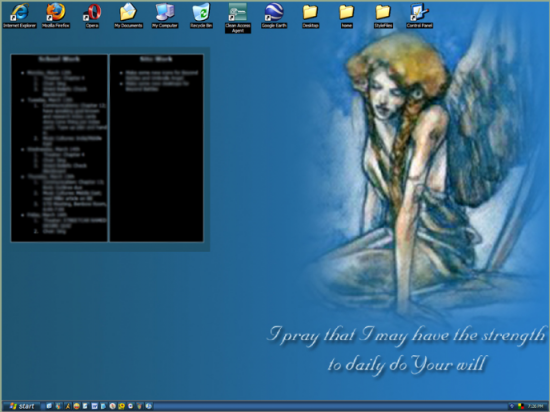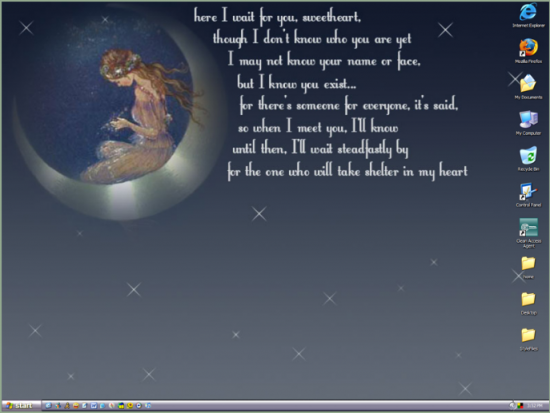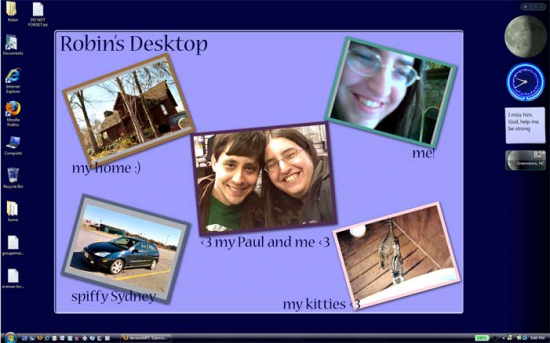As long as I’ve had a computer of my own (which was when I started college), I’ve had the urge to design backgrounds for my desktop. In a way, it was part of creating art for me–I wasn’t particularly good at drawing, wasn’t particularly good at coloring, but I did seem to be good at making desktop wallpapers.
Unfortunately, most of the wallpapers I’ve created over the last few years are locked on a hard drive that may or may not be recoverable :(, but I can share with you the few that I uploaded to my deviantArt account many moons ago. I can also give you a few tips on creating a desktop wallpaper that will be a delight to your eyes.
Picking the Desktop Style that’s Right for You
What you like as a wallpaper varies greatly, depending on what you need your desktop to do. I know plenty of people who cover their whole desktop with icons for files; I myself prefer a desktop uncluttered with icons (regardless of how my physical room looks…*snicker*). Other people have hyper-organized desktops with tons of informational widgets and gadgets all over the place, from daily calendars to how hot the CPU is getting, and so forth.
I’d say that your desktop should represent you, and should also be functionally beautiful for what you need. In the next few examples, I’ll show you various ways of organizing as well as decorating your desktop wallpaper.
Make it Expansive and Gorgeous
A wide, panoramic shot is great for a large-picture desktop; I favor nature pictures for these, and I try to make them as uncluttered as possible, with very few desktop widgets or gadgets. Any picture with a broad view, lots of color, or an amazing light effect works great for desktops.
This is a photo I took with my cell phone camera; I used it for several months as a desktop image, though I don’t have the actual desktop screenshot available. I loved the colors and plays of light and shadow in the picture, and so I fought to keep my desktop as clear as possible for this picture–I think I only had four icons on my desktop the whole time I used this picture. GASP!
A Desktop’s Not Just for Pictures
I like to include verses of poetry or quotes on my desktops, along with pictures or images. Usually I come up with my own poetry or quotes in direct response to what the image evokes in me; sometimes, though, I’ll mix my own words with someone else’s on the same desktop if I want a variegated desktop.
For these two screenshots, I show how I organize my desktop differently depending on my needs for that span of time.

Desktop January ’07 to March ’07
During the time this screenshot was up, I needed a constant HTML to-do list up on my desktop–thus, the large black area on the left, balancing the image (Sustaining Spirit, by Rebecca Guay) and my poetry on the right. (Had to motivate myself to do my homework somehow! I miss that functionality of Windows XP, to put an HTML page directly on the desktop…)

Desktop September ’06 to January ’07
For this desktop, I didn’t need a to-do list, so I just kept all the icons to a minimum and let the background speak for itself, with self-created poetry and a lovely image for which I cannot remember the source.
Make It Look Like a Scrapbook of Your Life
To create a “scrapbook” look, I’ll often put several pictures on a plain or subtly-patterned backdrop, arranging them so they look either neat or haphazard, either all together or spread out across the page. I find this to be an inspiring and fun background style to use on a daily basis–gives a little “oomph” to a bad day!
During this time, I was away from home and was very homesick, especially being away from awesome boyfriend of win, so I created this bulletin-board-like desktop with five real pictures, including a picture of us together. ^_^ I also had Vista’s Sidebar active (on the right, with some gadgetry in it), so I made sure the background did not compete with the Sidebar, nor did the icons on the left.
(Also, this was the infamous desktop that one of my classmates saw and asked, “Aww, is that your boyfriend? How many years younger is he?” I replied, “I’m twenty-FOUR and he’s twenty-NINE.” LOL)
Designing a Desktop of Your Own
To try out some of your own desktop art, pull out a few personally-meaningful photos, find some lovely patterns and images online (or make some yourself if you like), and start working. Play around in your favorite image-creation software or online image-manipulation site (like Pixlr or Aviary); arrange the photos and images any which way, add text if you want, and splash color all over it. It’s your desktop, after all–try everything and see what works best.
A few guidelines and tips for this process:
- Check out your monitor’s screen resolution settings before you design, and make sure your image is as close in size to the resolution as possible. For many of my old desktops, I designed for a 1024 x 768 resolution; later, I had to design for a 1300 x 1050 resolution (I think), and so on.
- Remember that the desktop background will likely be stretched a little bit to fit your screen if it’s not the same size as your monitor. Keep this in mind when selecting images, especially big images–you might end up with a funhouse-mirror photo!
- Know where you’d like to put your icons and desktop widgets before you start designing your background. In my June ’08 desktop, I knew that I wanted Vista’s Sidebar to display on the right, so I offset the pictures left of true center so that the pictures wouldn’t be shadowed.
- Try out “framing” your pictures in colorful patterns and shapes, and play with drop shadows and blur effects. These all seem to work well in a desktop setting.
Summary
Making wallpapers into “desktop art” can be an easier and more accessible way to involve creativity in your life. If you’ve never tried it, I encourage you to do so–who knows, you might make something truly inspirational!







